First Light






First Light
Dawn breaks in the desert, revealing a scurrying frenzy of creatures returning to shelter after the night’s mischief. Tallest among them, the Cycloptic Night-Seeker surveys the scene looking for any last morsel of food before the day’s solar onslaught forces its retreat into shadow. The Testapallidus at its feet may prove an ideal treat, unless the sand-swimming Armored Loricatus captures it first. Though the Testapallidus’ hard dorsal shell protects it from most threats, the Night-Seeker possesses a keen intellect, curious disposition, and two formidable front appendages that are as dextrous as they are sharp. Usually too quick for the large hunter, a trio of gregarious Desert Sentinels are more concerned with ambush predators such as the Loricatus, and one inflates its signaling air sacs in alarm. Already, members of the desert’s daytime cast are making an appearance. Luteos have positioned themselves at the top of the ridge to greet the first slanted rays. Relying on photosynthesis for a large portion of their metabolism, they tilt their bodies to follow the sun throughout the day. In a short time, more heat-tolerant daylight denizens will take the stage and play out their part in the everyday drama of the high desert.
More Posts from Exobiotica and Others






A Universe Below
Almost no sunlight penetrates the thick canopy of the glow forest. As a result, organisms in this ancient biome have evolved a massive array of survival strategies using bioluminescence. Some emit light to attract mates or warn against predators. And some, strangely, illuminate themselves in order to be eaten.






Monolith
The seasonal rains have come to the high desert. Among the first to respond is the monolith. It sends out hose-like tendrils to siphon water and turns on its biolights to attract flying symbionts.

A new environment with some new species here.
This is the first look into this particular biome- hopefully with more to come. All creatures depicted have a photosynthetic component to them - least of all the large plodding walkers, who rely most heavily on grazing for their energy intake. The creatures that resemble flowers are motile, but move less frequently. The long rope-like organism grows at a rapid pace to stake its claim over as much ground area as possible. The large round textures semi-spheres are not phased by this tactic, as they employ an electro-chemical defense over their outer surface to keep the strident ropes at bay.
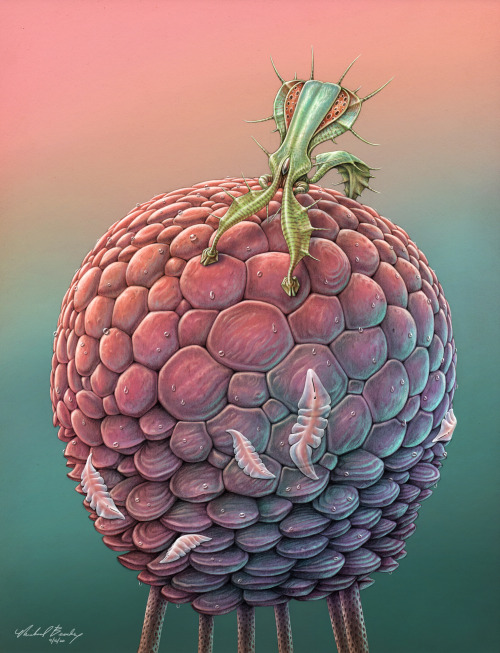
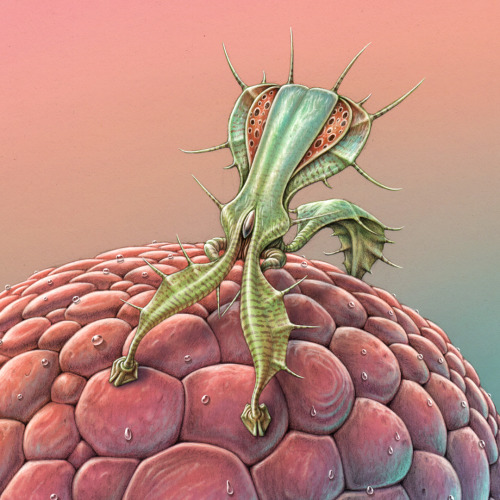
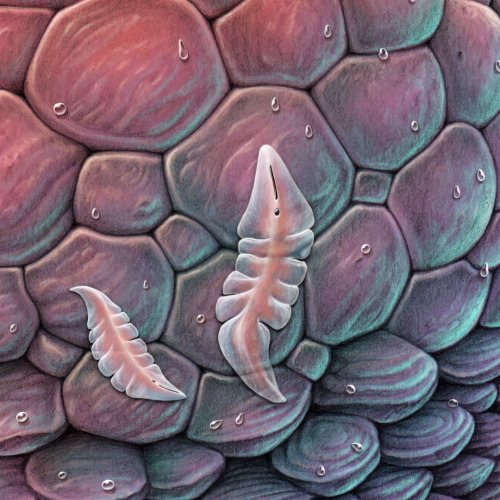
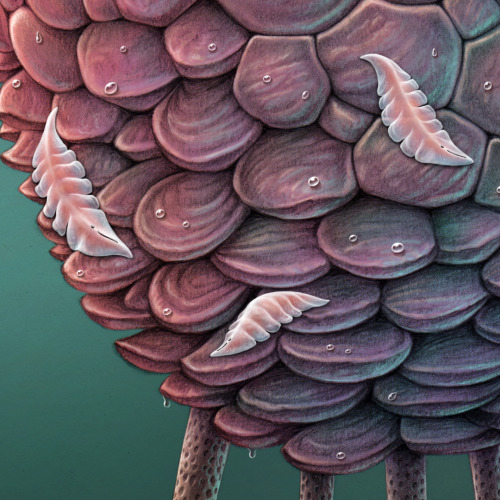
Guardian
On Veteris, it is common for creatures to obtain energy from multiple sources. The large round, multifaceted autotroph angles its plates to face the light at any given time of day. It also feeds on decomposing organic matter it obtains by moving slowly on its long spindly legs. Conversely, the spiny guardian on top originally evolved to hunt the semi-transparent flat creatures that feed on the autotroph, but came to rely on them exclusively. Over many generations, individuals that allowed some prey items to live and reproduce eventually outlasted the more aggressive hunters, and now their style of subsistence is closer to farming. The guardians now protect the entire micro-system – each large round walker and its flock of parasites is topped by a spiny guardian who has the dual task of defending against predators as well as keeping the herd numbers in check. A round walker without a guardian slowly succumbs to parasite overpopulation. Occasionally huge numbers of walkers congregate in vast gently-swaying miniature forests, each crowned by a flamboyant spiny guardian defending its small world.
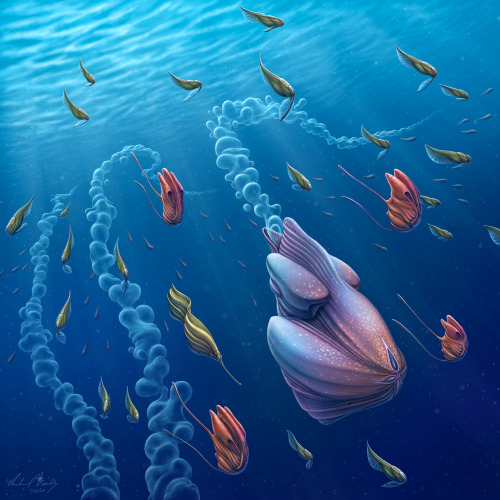
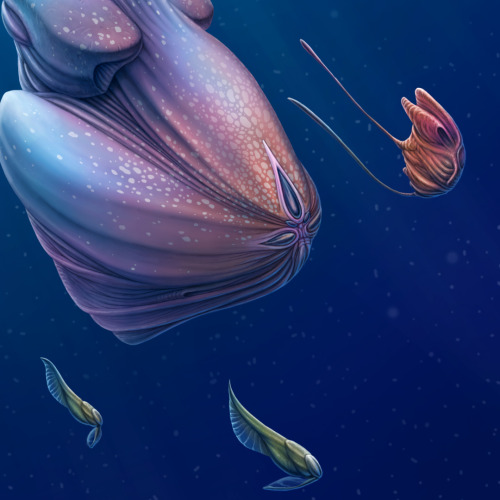
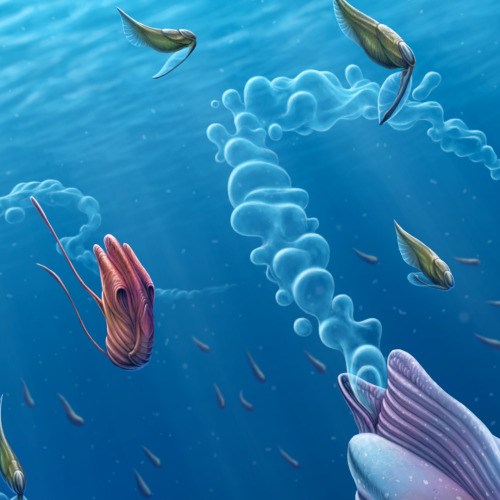
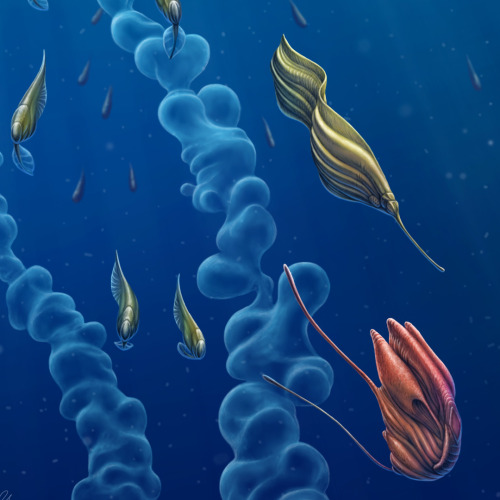
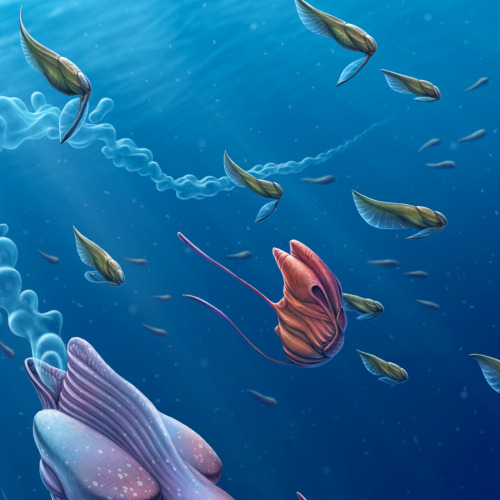
Back to the Depths
An entourage of opportunistic creatures accompanies the deep-sea behemoths during their brief ascent to the surface. Releasing their gelatinous strings of embryos here in the sunlight has a significant benefit - there's far more visibility. The swarm of followers are here in search of a quick meal in the form of the gelatin, which is full of valuable protiens and nutrients. After the feast however, the recipients of this apparent windfall become unwitting hosts for the behemoth's multitudinous offspring, which were embedded in the gel. Adapted to develop inside a wide variety of pelagic creatures, the young grow internally - and sometimes even on the surface of - their hosts until such time as they detach and sink back into the darkness. For most host species, this seems to be a mutually-beneficial symbiosis. At the beginning they receive a large and valuable meal, and usually incur very little detriment due to their temporary parasites. The young behemoths will hide in the dark depths for many years until attaining the size necessary to return to the light and repeat the ancient cycle again.

This was a colored-pencil rendering of the creatures involved in the ecosystem portrayed in the "Aglow" piece. The pancake creatures on the floor are mobile decomposers. The floating lanterns are semi-autotrophic creatures that travel in groups. They travel by spouting air directionally through their vents which are visible along the middle of their bodies.




Kings of the High Desert
A herd of strange creatures has congregated on this rocky outcrop. Known as Emperor Shinebacks, they often climb these rugged foothills to obtain access to cooling breezes and additional food sources. Their top-heavy tripodal stature prevents further ascension into the mountains, but it serves them well on more level ground. Reflective carapaces mitigate much of the sun’s harmful rays, and cooling flaps along their flanks dissipate excess heat. A shineback’s normal gait is rather clumsy, but when haste is needed they clamp all three legs together into a single monopod and bounce effortlessly across the desert at remarkably high speeds. This combined with their massive size (adults are over eight feet tall) and protective social behavior makes them almost impervious to attack. Almost…





A Giant Forest Walker

I've decided to start posting sketches more often, as they comprise over 90% of my artistic time. This is the Greater Parvasalia. It travels in large groups, is about the size of a hamster, and is generally non-aggressive. More details as they are developed.

Quick sketch I hope to make into a full painting later.
-
 murkyskull liked this · 1 month ago
murkyskull liked this · 1 month ago -
 fattcatt1123 liked this · 4 months ago
fattcatt1123 liked this · 4 months ago -
 fearless-seagull liked this · 5 months ago
fearless-seagull liked this · 5 months ago -
 begeldverl liked this · 6 months ago
begeldverl liked this · 6 months ago -
 onemillionfish liked this · 6 months ago
onemillionfish liked this · 6 months ago -
 anauthorwhoknowsnothing reblogged this · 6 months ago
anauthorwhoknowsnothing reblogged this · 6 months ago -
 anauthorwhoknowsnothing liked this · 6 months ago
anauthorwhoknowsnothing liked this · 6 months ago -
 deathlyborb liked this · 6 months ago
deathlyborb liked this · 6 months ago -
 johnbrownanarchist liked this · 7 months ago
johnbrownanarchist liked this · 7 months ago -
 scottbaiowulf reblogged this · 7 months ago
scottbaiowulf reblogged this · 7 months ago -
 bycampfirebepurged liked this · 7 months ago
bycampfirebepurged liked this · 7 months ago -
 suroboro liked this · 7 months ago
suroboro liked this · 7 months ago -
 tamarsart liked this · 8 months ago
tamarsart liked this · 8 months ago -
 critterbugboi liked this · 8 months ago
critterbugboi liked this · 8 months ago -
 trillobite liked this · 8 months ago
trillobite liked this · 8 months ago -
 tiredboxman liked this · 8 months ago
tiredboxman liked this · 8 months ago -
 grokkensgrumblings liked this · 8 months ago
grokkensgrumblings liked this · 8 months ago -
 tundragravedigger reblogged this · 8 months ago
tundragravedigger reblogged this · 8 months ago -
 tundragravedigger liked this · 8 months ago
tundragravedigger liked this · 8 months ago -
 magnificentnachobeliever liked this · 9 months ago
magnificentnachobeliever liked this · 9 months ago -
 crimnsontroll liked this · 9 months ago
crimnsontroll liked this · 9 months ago -
 annoyinglyeclecticruins reblogged this · 10 months ago
annoyinglyeclecticruins reblogged this · 10 months ago -
 annoyinglyeclecticruins liked this · 10 months ago
annoyinglyeclecticruins liked this · 10 months ago -
 pompadorned reblogged this · 10 months ago
pompadorned reblogged this · 10 months ago -
 whateverthewiz reblogged this · 10 months ago
whateverthewiz reblogged this · 10 months ago -
 whateverthewiz liked this · 10 months ago
whateverthewiz liked this · 10 months ago -
 cunnnilinguist liked this · 10 months ago
cunnnilinguist liked this · 10 months ago -
 ara6gir liked this · 10 months ago
ara6gir liked this · 10 months ago -
 patientowl27 liked this · 10 months ago
patientowl27 liked this · 10 months ago -
 ambrosia-marrow liked this · 10 months ago
ambrosia-marrow liked this · 10 months ago -
 partumreblogs reblogged this · 10 months ago
partumreblogs reblogged this · 10 months ago -
 grigadf liked this · 10 months ago
grigadf liked this · 10 months ago -
 prismaticmint liked this · 10 months ago
prismaticmint liked this · 10 months ago -
 lamehandle liked this · 10 months ago
lamehandle liked this · 10 months ago -
 federaldime liked this · 10 months ago
federaldime liked this · 10 months ago -
 teil-dealer22 liked this · 11 months ago
teil-dealer22 liked this · 11 months ago -
 tinysweetnight liked this · 11 months ago
tinysweetnight liked this · 11 months ago -
 lexiansgarbagecan2 liked this · 11 months ago
lexiansgarbagecan2 liked this · 11 months ago -
 lotoform liked this · 11 months ago
lotoform liked this · 11 months ago -
 trenchonthenet reblogged this · 11 months ago
trenchonthenet reblogged this · 11 months ago -
 trenchonthenet liked this · 11 months ago
trenchonthenet liked this · 11 months ago -
 beepfish liked this · 11 months ago
beepfish liked this · 11 months ago -
 avahkadoo reblogged this · 11 months ago
avahkadoo reblogged this · 11 months ago -
 avahkadoo liked this · 11 months ago
avahkadoo liked this · 11 months ago -
 cheeki-tails liked this · 11 months ago
cheeki-tails liked this · 11 months ago -
 entomycetic reblogged this · 11 months ago
entomycetic reblogged this · 11 months ago -
 f0ssil-cl4y liked this · 11 months ago
f0ssil-cl4y liked this · 11 months ago -
 heraldofmultiverses liked this · 11 months ago
heraldofmultiverses liked this · 11 months ago -
 tolbachik liked this · 11 months ago
tolbachik liked this · 11 months ago